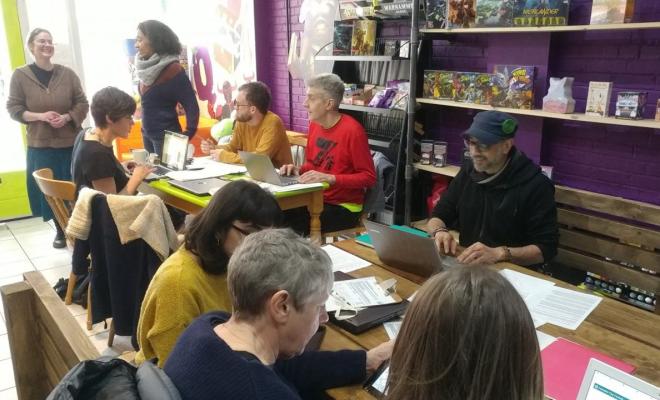17 Apr 2025
You are entitled to protest on the pavement. If the protest blocked the pavement it could give rise to the offence of obstruction of the highway. It will depend on what was reasonable in the circumstances. Also, if it is a bigger demonstration the police may impose conditions, and if those conditions are breached it could give rise to offences (as per the guidance on power to impose conditions and breach of conditions).
This is your decision to make as a group. You should consider the following factors when considering attending a far-right counter-protest:
- Is it safe for you and your group to attend? In particular, consider your group members who are marginalised by race and religion and more likely to be targeted by the far-right.
- Can you contact the counter-protest organisers to confirm if they'll have a police presence to protect counter-protesters against violence and contain far-right rioters if they get violent?
- Will the organisers provide stewards?
- Will you and your group be easily identifiable by far-right groups in the future? You should make sure you wear plain clothing and cover anything identifiable such as tattoos or hairstyles.
Remember that it’s OK not to attend these protests and you’re not letting anyone down if you choose not to go. There are many ways you can support anti-racist groups and act in solidarity with marginalised communities. For example, as a group you could send a letter to affected groups sharing your solidarity and asking what support they need. Use this template letter to contact your local partners.
If you’re unsure what to do, contact your regional staff member to talk about the counter-protests.
Yes. The provisions of the Public Order Act 2023 related to locking-on include linking arms or attaching yourself to another person or object even when no additional materials are used.
The low threshold for what constitutes “serious disruption” under the Public Order Act 2023 ensures that locking-on is a very broad offence. See the section on “serious disruption”.
In theory, the Public Order Act 2023 is so broad that it could apply to a lot of objects from superglue to bike locks, tape, rope, etc.
Intention is ordinarily alleged to be inferred from the circumstances and can include things said, any particular behaviour, the location, the item carried etc. However ultimately "intention" is what was in the contemplation of the individual. Therefore, one can seek to explain if an actual intention is different to that which is alleged.
If you are prosecuted, it may be harder to prove that a shoelace or a belt was carried with the intent of locking on, but the case of the Republic protestors shows that carrying even relatively commonplace objects such as luggage straps may be used as a grounds for arrest.
It is notable that none of the Republic protestors arrested at the King’s Coronation were charged, and that the police subsequently expressed "regret" that these arrests had taken place. The police were threatened with legal action when no charges were brought.
A police officer has powers to stop and search you if they have "reasonable grounds" to suspect you’re carrying: illegal drugs, a weapon, stolen property, something which could be used to commit a crime.
This should be based on objective factors such as things said, any particular behaviour, location, particular clothing that may be concealing identity etc. It is not permissible for these powers to be exercised on discriminatory grounds.
No, organisers cannot be held liable for the actions of others if the organiser has no involvement in the alleged criminal conduct of others.
In relation to protest legislation, organisers or any other individual inciting another person to attend a protest and breach a condition that has been imposed by the police, that they knew or ought to have known about, is a specific offence.
The sentence is up to 6 months imprisonment or a fine of up to £2,500, or both.
Advertising or promoting a lawful protest is not an offence. You would not be responsible if the demonstration subsequently had conditions imposed on it, after you had advertised it. In fact, this issue came up in the legal advice Friends of the Earth received in the lead up to Extinction Rebellion’s “The Big One”.
However, incitement to breach conditions is an offence. So if you knew or ought to have known about police conditions at the time of advertising or promoting a protest, but you advertised or promoted the protest in a way that encouraged people to breach those conditions, then you could face prosecution. For example, encouraging people to protest at a location that the police have said cannot be used is an offence.
Stewards may be at greater risk than other protestors if the police are seeking to stop a protest (but this is based on a tactical decision by police that by arresting stewards the protest will be weakened, rather than any specific legal powers). Stewards may also be expected to have a greater degree of knowledge of any conditions imposed on the protest.
If you’re organising a march, you should inform the police 6 days before your planned protest march. See more info on the section above on “Providing written notice”. The Human Rights Act and Articles 10 and 11 of the European Convention on Human Rights (ECHR) mean that the police have a legal obligation to facilitate your protest.
Chalking on pavements may be safe to do. However, it’s important to note that there have been cases of people charged with criminal damage in relation to chalking, from an innocent game of hopscotch to a vegan activist writing a pro-vegan message outside a McDonalds restaurant. Under the Criminal Damage Act 1971, an offence can be committed even if the damage is not permanent. The best advice is to err on the side of caution and be conscious of the people around you. The case where teenagers were given penalty notices for using chalk to draw hopscotch resulted from the housing association body making a complaint.
It is hard to be sure. Our experience has been that we have been able to temporarily attach banners to structures eg tying banners to the railings outside a building (for example attaching banners outside the Royal Courts of Justice on the morning of a court case), and the police have not intervened to stop this. Keep in mind that the offence of locking on is committed when serious disruption results (albeit this now has a low threshold). Banner drops have been stopped by police. You may be asked by police to remove banners due to (road) safety concerns.
This could constitute aggravated trespass if the bank were not able to operate. It could also meet the threshold for serious disruption (though less likely if the bank continued to operate as normal) for the imposition of a police condition requiring you to protest elsewhere. However, communication with police at the scene could reduce the risk of arrest if your protest were for a limited time (say 15 mins). However, this is not guaranteed.
Generally, you can make as much noise as you want if it is not amplified (ie, using a megaphone or speakers; bear in mind special rules apply near parliament). The only change following the new laws is that if your noise could reach the threshold for "serious disruption" the police could place a condition on your protest, perhaps to reduce the volume or the number of people or the means for making the noise. It is an offence to breach such a condition, but complying would mean you commit no offence.
...could we be arrested? Previously we didn't have to inform the police for a static stall or protest, only if we were marching/moving.
No risk if it's agreed with the council or other landowner, and little risk even if it hasn’t been agreed as it would be unlikely to meet the threshold for serious disruption.
There may be different issues if the protest is on private property in which case private security might seek to move you on. There are offences under the Criminal Justice and Public Order Act 1994 in relation to trespass.
Although a lot of protests will take place physically it’s important to be aware of the potential digital implications – from advertising someone else’s protest online or organising your own. Here's a few ways to help keep your communications and campaigning safe and secure. Please remember, they might help improve your online safety but no method is 100% fool-proof.
- Protect the privacy of your communications: Use encrypted communication channels whenever possible. Look for services that provide end-to-end encryption, which ensures that only the intended recipient can read your messages. Services like Signal for messaging (rather than WhatsApp) and ProtonMail for email offer strong encryption options.
- Be aware of open collaboration platforms: while Google Docs offers convenience for collaborative document work there are concerns around privacy, data ownership, and the potential for accidental sharing or unauthorised access. You might want to explore alternatives such as CryptPad, Microsoft365 or OnlyOffice.
- Use strong and unique passwords: set up strong, complex passwords for all your online accounts. Avoid using common or easily guessable passwords. Consider using a password manager to generate and store your passwords securely.
- Enable two-factor authentication (2FA): this adds an extra layer of security by requiring a second verification step, such as a code sent to your phone or a biometric scan, in addition to your password.
- Be cautious with public wi-fi networks: public wi-fi can be insecure so avoid accessing sensitive information or logging into important accounts when connected to public networks. Consider using a virtual private network (VPN) to encrypt your internet traffic and protect your data.
- Be cautious on social media: be mindful of the information you share on social media platforms. Adjust your privacy settings to limit access to your personal data and be cautious about accepting friend requests or connecting with unknown individuals.
- Secure your devices: use device passcodes, PINs, or biometric locks (such as fingerprints or facial recognition) to protect your smartphones, tablets, and computers from unauthorised access. Enable device encryption to safeguard your data in case your device gets lost or stolen.
- Keep your software up to date: regularly update your operating system, web browsers, and applications to ensure you have the latest security patches. Software updates often include bug fixes and security enhancements that can help protect your devices.
- Be mindful of phishing attempts: be cautious of suspicious or unsolicited emails, messages, or links that ask for personal information or login credentials. Phishing attacks often try to trick you into revealing sensitive data. Verify the authenticity of requests by contacting the organisation directly through their official channels.
- Regularly backup your data: regularly back up your important files and data to an external hard drive, cloud storage, or another secure location. This helps protect your information in case of device loss, damage, or ransomware attacks.
Follow our steps on what to do before and after a protest.
This guidance is based on, and draws significantly from, material from Liberty. We'd like to thank them for this, and for their kindness and support for local action groups. Find out more about Liberty, the actions they take for civil rights and how we can work together. We're grateful to Shahida Begum barrister at Garden Court Chambers for reviewing and editing this guidance.
Disclaimer: this guidance is designed to provide an overview of the types of protest-related offences, the sentences they carry upon conviction, and some practical ways to approach organising and participating in a protest. It does not constitute legal advice, which must always be tailored to the specific facts of a given case or circumstance. It’s also important to note that some of the offences described in this document are very new, with few or no prosecutions relating to them to date.





